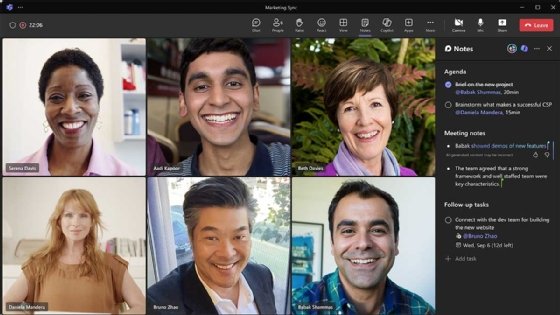5 key video conferencing trends to watch in 2025
From personal assistants to meeting summaries, AI will redefine video conferencing over the next year. Check out the top trends driving the market in 2025.
The year was 1969 when the United States first landed a man on the moon, changing the way humanity saw itself in the process. Today, AI holds the same potential. The technology dominates almost every discussion of what is happening right now. Fifty years from now, we might view AI in the same way we measured 1969 and the moon landing.
Consider video conferencing, which is fundamentally being transformed by AI. In fact, when forecasting the five biggest expected video conferencing trends for 2025, each is underpinned by AI.
Even a few years ago, these trends would have been considered science fiction. But the future is now. These aren't technologies in development; indeed, most of these are already available, or will be soon. Let's take a look.
1. AI-driven meeting summaries
Meeting transcriptions -- some powered by rudimentary AI -- are nothing new. What exists today, however, is on another level and completely transformative. The combination of generative AI and natural language modeling makes these meeting summaries far more useful and compelling than the AI of 2022.
This article is part of
The enterprise guide to video conferencing
Check it out yourself. Anyone with a paid Zoom or Webex by Cisco account can try out their respective AI assistants. Microsoft's Copilot AI assistant is also available for additional fees. For Zoom, I enabled Companion through my online account settings. Following my next meeting, I received an email with my generative AI summary.
I expected a few bullet points, but what I got was a comprehensive, concise and easy-to-read summary composed in natural language. It was hard to believe it wasn't written by a skilled human personal assistant who understood who I am and the context of my meeting. The to-do items at the end of the summary alone were incredibly helpful.
As I read the summary, I saw important items I otherwise would have forgotten to follow up on. There was a moment of almost panic, as I realized how much I'd been missing from my meeting wrap-ups and how much more effective I could have been all these years. For me, this new generation of AI meeting summaries is a game changer.
2. AI-powered in-meeting support
Today's AI isn't just helpful after the meeting is over; it can help during the meeting. A prime example is mini summaries designed to let participants catch up if they are late or step out for a few minutes during a meeting. Another key feature is to create action items in real time.
As AI bots continue to develop, I expect them to function more and more like human personal assistants who understand what users do inside and outside of a meeting. If, say, employees are in a meeting and discussing a subject one participant recently wrote about, the AI assistant will (unprompted) find that file and make it available should that participant choose to share it. If someone in the meeting suggests scheduling another meeting for Wednesday, the AI assistant will immediately access the calendar and let users know their availability.

The best way to think about these AI services is to personalize them and pretend they are a person who is on your side and wants to help you. These aren't the bots of the past that simply respond to prompts. You can act as if they understand what is happening and they will support you accordingly. That is what makes this technology more than just another meeting productivity tool.
3. AI-enabled multi-camera direction
Most companies have embraced the new hybrid workstyle without major issues. Workers have demonstrated they are as productive at home as they were in their cubicles. Team chat and video keep us connected and enable us to collaborate with our creative teams. Despite this success, hybrid work has highlighted a serious issue: The lack of meeting equity.
The meeting equity problem is simple to understand. Everyone who hops on video from home these days looks great! Remote participants all have figured out how to properly frame themselves to fit the screen like a newscaster on TV. Meanwhile, staffers who are in the office's meeting room look small. That's because meeting room cameras generally pan out to capture the whole room.
As a result, looking at the gallery view of a hybrid meeting, people from home are full-sized and people in the meeting room are tiny. This gives an advantage to those working from home, because image enables them to be more effective presenters and communicators. Meeting equity is not just a vanity issue about who looks nice on screen. Instead, it's about successful collaboration.
Initial attempts to solve this problem generally involved activating voice tracking software on the meeting room camera. The camera would use (comparatively simple) AI to zoom in on whoever is talking. This was certainly an upgrade to the static wide shot, but participants would lose the view of everyone else in the room.
The latest generation of products aimed at solving the meeting equity challenge uses AI to act as a video director controlling multiple cameras in the room. The AI is smart enough to not only detect people in the frame, but to understand which camera best captures each person in the room. Even as people move around or enter/leave the room, it can, in real time, adjust all of the room's cameras to capture a clear view of each participant's face. It can then, in software, digitally crop and reframe each person's image to give a personal panel when viewed in the Zoom, Teams or Webex gallery setting.
The end result is that with AI-driven multiple-camera direction, everyone's image is consistent. You can't tell who is at home and who is in the meeting room because each panel contains a perfectly framed face.
4. AI monitoring for enhanced productivity
I've only seen this in demos so far, but this video conferencing trend offers great potential. During a meeting, AI can observe participants' behavior, stress levels, posture and vocal tones. By analyzing these cues, it can offer real-time feedback to improve engagement, encourage breaks when stress levels rise and suggest posture corrections for better concentration.
In other words, AI will help participants be more productive and avoid burning out. It will also analyze their presentation style to become more effective communicators. It's like having a personal acting coach. I regard these advances as revolutionary. These aren't just tools that will help everyone be more productive; these are tools that will change the way people work.
5. AI-powered dynamic background changing
This might not be the most significant trend, but the market will see a lot of activity here. Virtual backgrounds and other filters and effects might not increase productivity, but they certainly make participants feel more comfortable and happier during a video conference.
Virtual backgrounds and "touch up" filters have been incredibly popular, even before the COVID-19 pandemic. Regardless of the motivation, such as a need for privacy or a desire for personalization, people love their virtual backgrounds.
Just like everything else, AI is taking this to the next level. One demo I saw used AI in a particularly clever way. Rather than replacing a background with a virtual one, the AI analyzes the user's background and offers options to improve it. AI can virtually redecorate a room, for example, placing better art on the wall or cleaning up unorganized bookshelves.
I think this is absolutely brilliant. The people I meet with over video will still see my actual room for the most part. But it won't be like using a virtual background that places me in Paris. It will, instead, just be a better version of my room, if I were a more organized person with better taste.
Ideas like this would have been completely unthinkable even a few years ago, and today it is so real I've seen a demo. It makes me wonder what else today's AI can do that we have yet to discover.
Editor's note: This article was updated in December 2024 to improve the reader experience.
David Maldow is the founder and CEO of Let's Do Video. He has written about the video and visual collaboration industry for almost 20 years.







